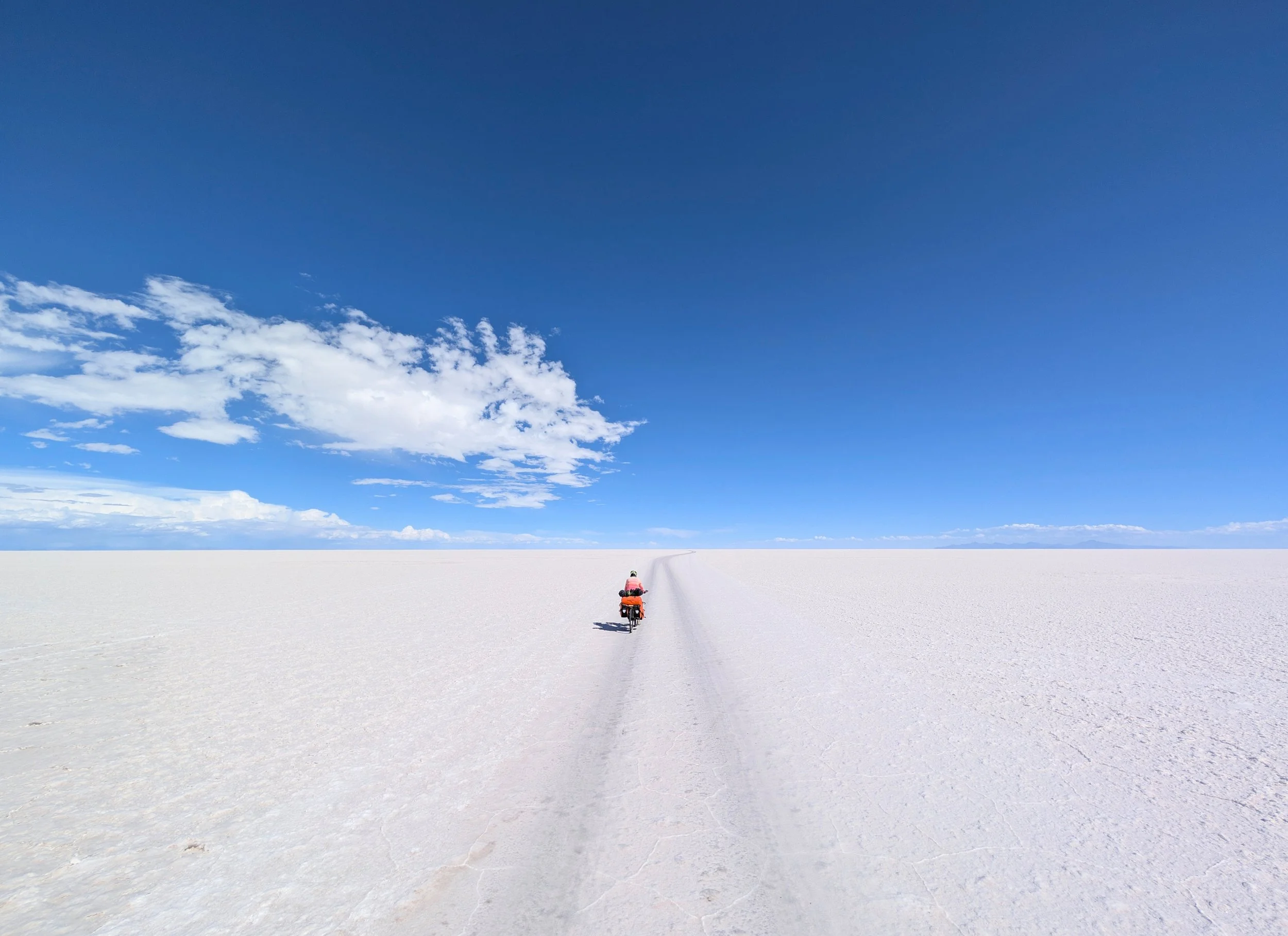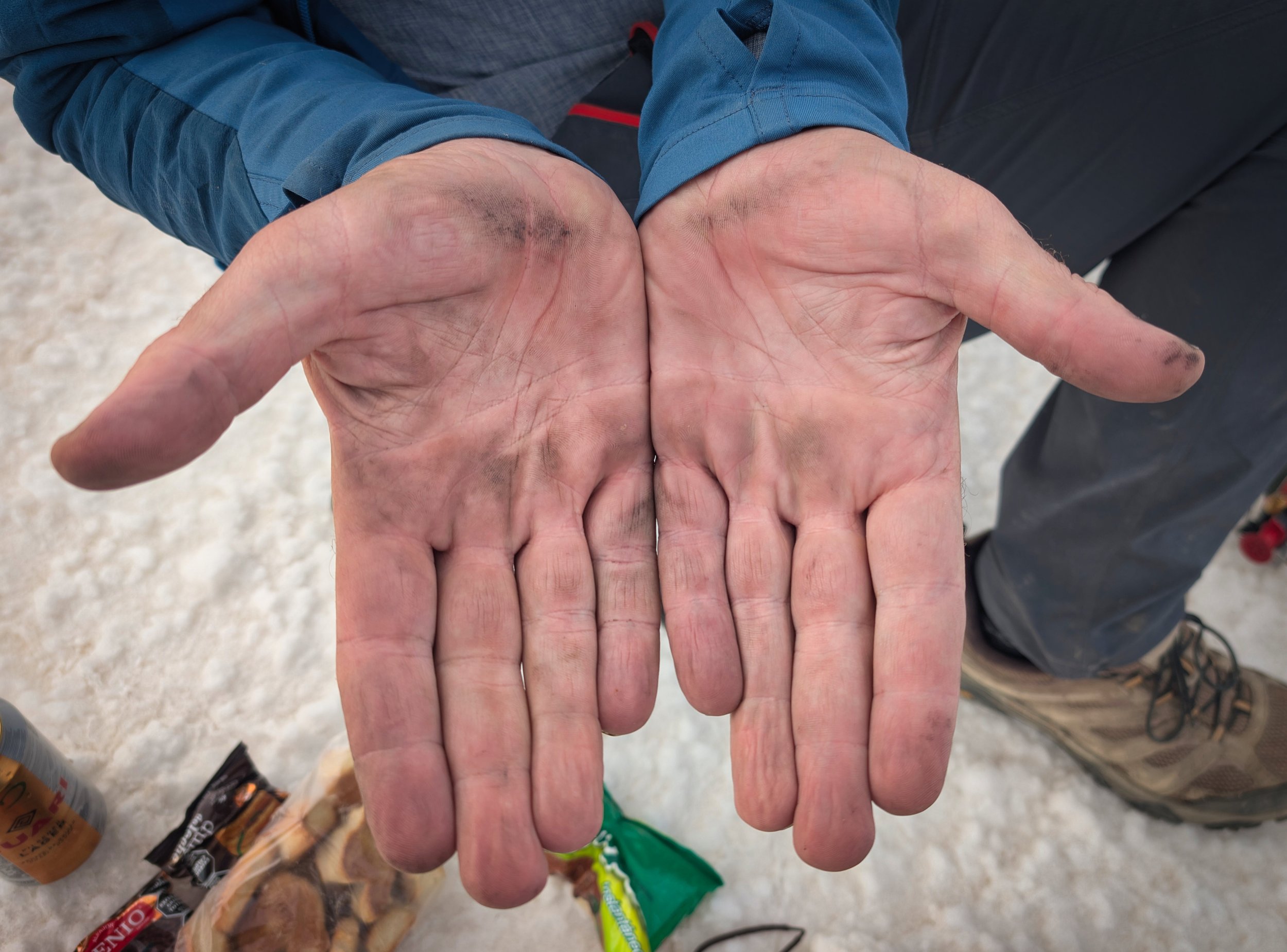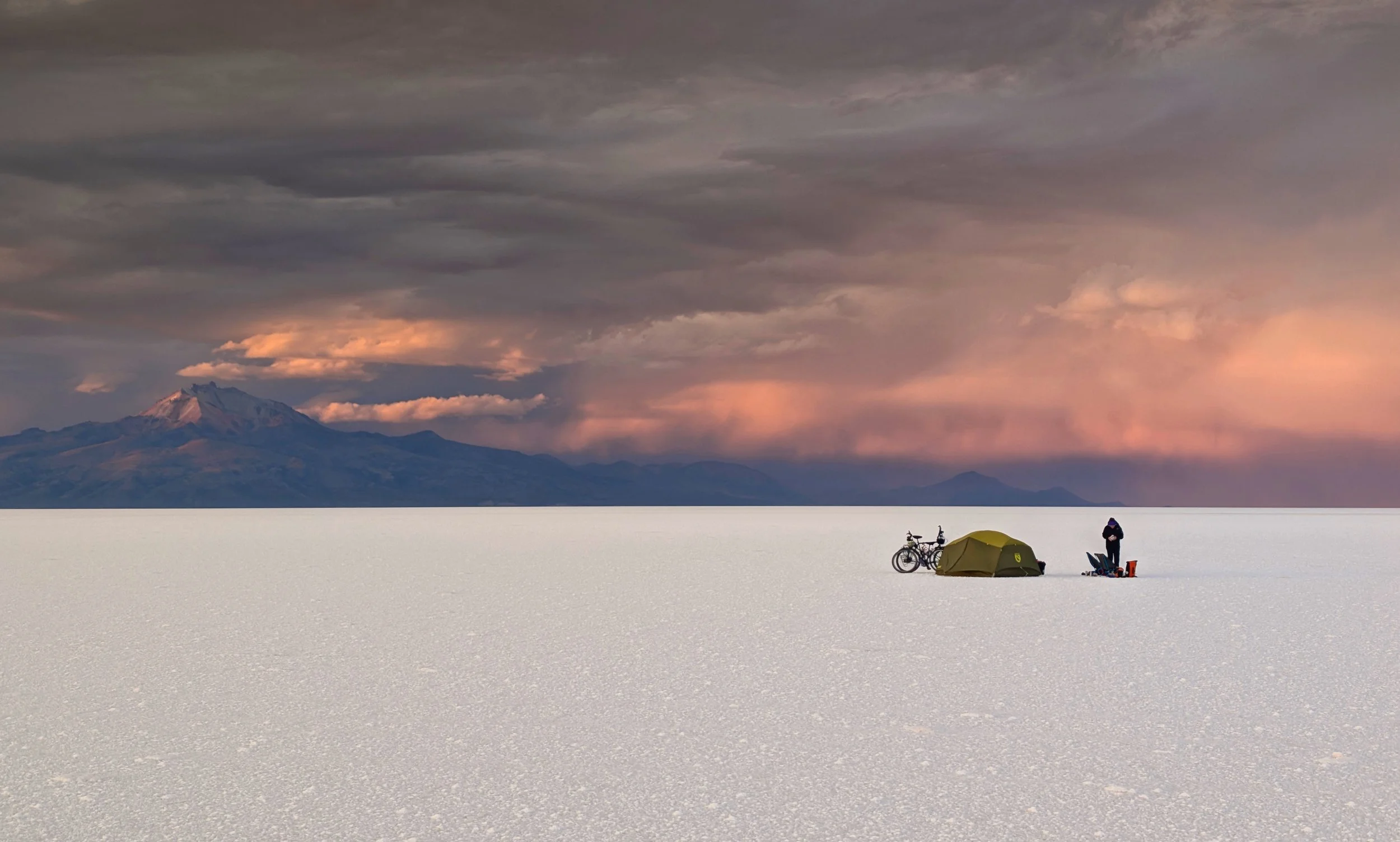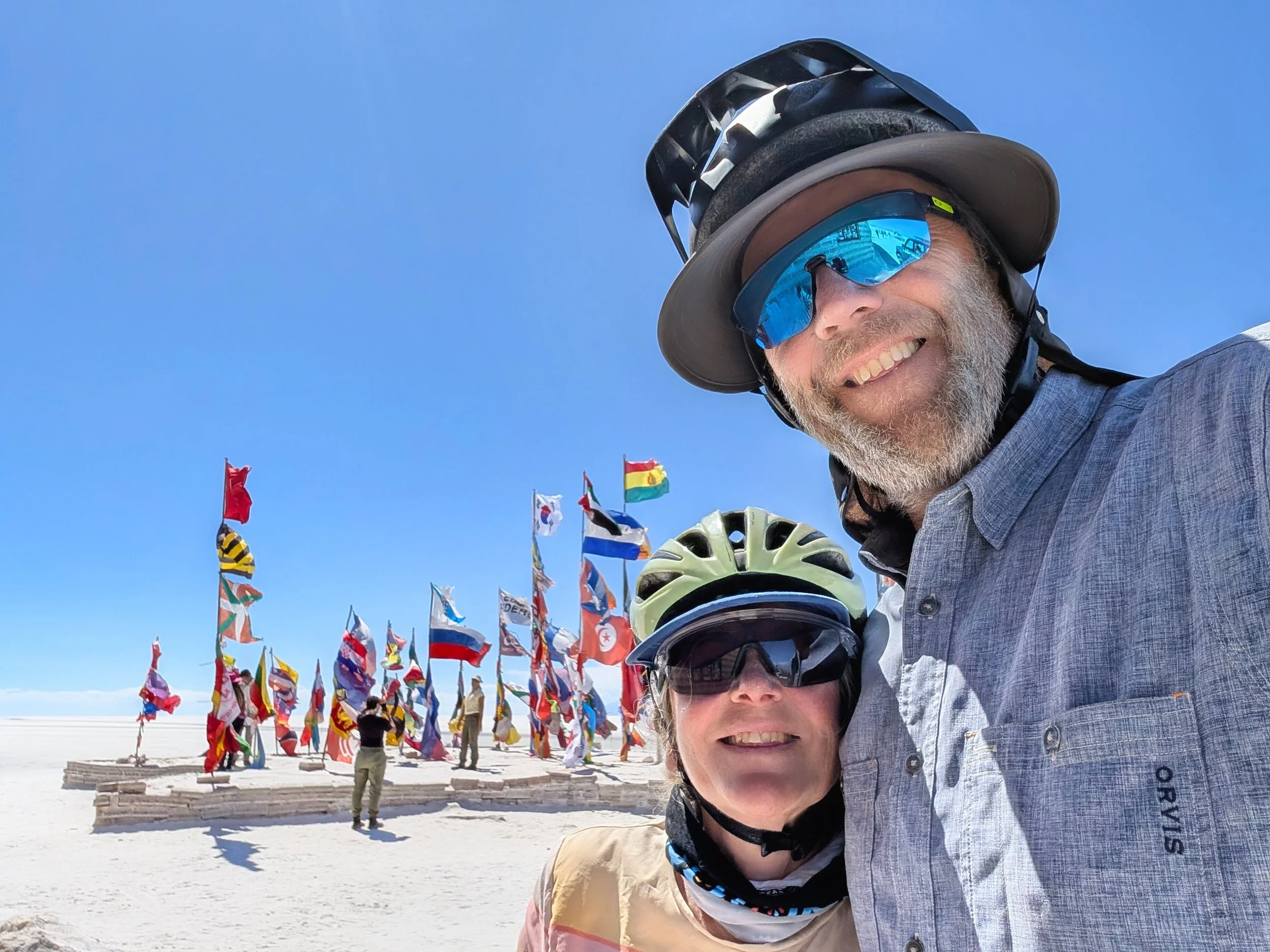Day 1,581
Salar de Uyuni
Back in 2020 we made plans for our trip around the world and the top places we wanted to visit. Number 1 for Tom was the Salar de Uyuni. We nearly made it in 2023, and in 2024 we were just days away, but fate intervened on both occasions and we were sent homeward bound. But now, in October 2025 we are finally here. We stood just a mere mile for the outer edge of the Salar, finally our time had come, we were about to ride across it!
Saying goodbye to ‘the mainland’
So, what is the Salar de Uyuni? Well, it's the largest salt flat in the world at over 10,000 sq kilometres (4,000 sq miles). It sits at around 3,656 metres (11,995ft) feet above sea level. Its size means it's easy to spot from space, and it's flat, with only around a metre difference in height over its whole surface. This means it is very useful to the scientific community. They can calibrate their satellites, laser altimeters, and much more.
The view with Tunupa behind us
So where did it come from? Well, are you sitting comfortably? OK, I'll begin. Around 42,0000 years ago there was a very, very big lake, Lake Minchin. Over the centuries this evolved into Paleo Lake Tauca. When it dried up it left two great lakes, Poopó and Uru Uru, and two salt deserts, Coipasa and Uyuni. Lake Poopó is a neighbour of the much larger Lake Titicaca, which during the wet season overflows, flooding Lake Poopó which in turn overflows and floods the salars of Coipasa and Uyuni. Causing a wet mirror like wonderland, that draws tourists and wildlife in abundance. Dotted over the salar are small islands which are actually the tips of long dormant volcanos. The surface is a solid salt crust varying in thickness from tens of centimetres to several metres.
Or, once upon a time, according to the local Aymara people, legend has it that the surrounding mountains of Tunupa, Kusina and Kusku were actually giants, and well it’s the old story of love and betrayal. Kusku and Tunupa married and had a son, he then had an affair with Kusina. Tunupa discovered this whilst breastfeeding their son. She started to cry and her tears mixed with her milk fell and formed the salar.
Take your pick. Whichever, I feel the locals definitely deserve to be able to call their salar after Tunupa rather than the nearby town of Uyuni.
Just a few more facts, the Salar is mined for salt, though only a tiny percentage of what's there. It holds nearly 22% of the world's lithium, found below the surface in a layer of brine. In the past large corporations had mines here, but local opinion was fiercely against that and now no mining takes place, but it’s expected that the Bolivian government will perhaps restart that themselves, although technical problems with extraction may hold this back.
Lesson time over!
A cycle tourist’s hands
For us we just wanted to experience cycling across this unique landscape. It was a journey of over 70 miles. We arrived mid-afternoon after 45 miles of pretty hard riding. We had cycled around Mount Tunupa, which itself was worthy of the effort taken to get here. She dominates the skyline for miles around and her surface is a mixture of stunning coloured rocks.
We were too impatient to wait and decided to set off and camp on the salar. The hard packed salt was wonderful to ride on and the first couple of miles flew by. Our senses were struggling to comprehend what we were seeing. Everywhere we looked, 360°, was a vista of white. We knew it was salt but our brains kept telling us it was snow. As the hot sun beat down upon us we expected it to melt, rather than dry out.
The surface is dotted with tracks as the Salar is actually a major road access across the altiplano, and though we only saw a few vehicles, we became aware of the track the truckers used and further south the tourist vehicles. At no point though did we share our track with a vehicle, silence and solitude prevailed.



















Around 5pm we decided to set up camp. We had brought a rock with us to help drive the tent pegs into the salt, and it was needed, in fact we should have brought a bigger one as this was probably the hardest surface we've pitched on yet. Around us to the north storms were brewing across the mountain tops, or Giants, whilst to the south we had a stunning sunny backdrop. The vast size of the salar forms a barrier, or a climatological transitional zone as those scientific bods call it. Whichever, the storms stayed in them there hills and we had a dramatic ever changing backdrop to our campsite. The combination turned a stunning view into a magical evening's entertainment. The air was completely still, with no bugs to annoy us we sat up late into the night, just drinking it all in. Finally we were driven into the tent by the daily arrival of strong nighttime winds. We did have a few worried moments into the early hours, but our beloved Nemo did us proud.
One side was a lovely sunset
The other, slightly worrying
Despite our fears, the temperature overnight wasn't too cold. Friends had endured minus twenty but we slept snug and warm in Nemo. In the morning we were up to watch the sun rise, before packing up.
Now there was just one more thing to do before setting off. Tradition has it that cycle tourers must ride a portion of the salar naked and we are nothing if not traditionalists. It was a fun and liberating few minutes, but we were very happy to don our normal kit, and very happy we hadn't fallen on the salar as our friend Ferdi did last year. Salt is very abrasive on naked skin, especially if you fall off your bike whilst performing a wheelie apparently!
Tradition!
Now we had just over 60 miles to go. A few miles over a reasonably good surface brought us to the Isla Iscahuasi. It's one of those volcano tops and is covered in enormous cacti, the tourists come in their droves, but we paused just to eat a quick snack, as we had nearly 50 miles of salt to ride and we couldn't wait.
Now I'd love to say that every metre was a joy, but it wasn't. Salt generally isn't a super smooth surface. What we experienced was a mix of smooth, rough, very rocky, great divots and potholes to the abyss, some so big we worried about falling into that briny mixture and ending up in another dimension. Combined with the endless vista of salt and the sun growing hotter as it beat down upon us and reflected up at us, it made for a very tiring and uncomfortable ride. We probably hadn't eaten enough either, so not a great combination.









But, as ever, we made it. Now we have rested up for a day, the reality of what we experienced and achieved is finally sinking in. With a combined age of 118, still acclimatising, on heavyweight, narrow-tyred touring bikes, we've ridden across the largest salt flats in the world, and cycled over 28,000 miles over 4 years to get here. Daft we maybe, but we're also pretty proud of ourselves too.
Proud and relieved, in equal measure






